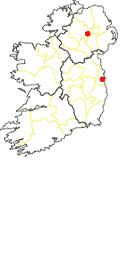
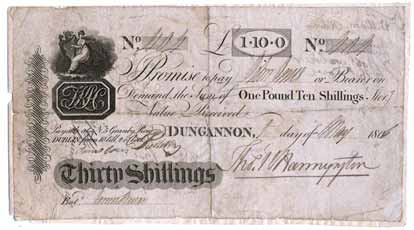
Thomas Knox Hannyngton operated as a banker in the early 1800’s with offices in Dungannon, County Tyrone and Dublin (No.5 Granby Row). Hannyngton's extended family was involved in politics, one of them being an MP.
He appears to have had a colourful banking career going through bankruptcy in 1806 and again in 1816. The second bankruptcy proceedings lasted for many years with notices in newspapers up to 1842. Hannyngton’s name is also spelt sometimes as Hannington in notices.
Hannyngton's is one of the few private banks which is known to have issued notes from more than one branch. The best known bank with notes of more than one branch is Ffrench's Bank, of which there are many surviving notes known issued by Tuam and Dublin. Other examples are two banks based in Sligo, each with a branch in Dublin, John McMullin and Co. 1802-1806, and McCreery and Ballantine 1805-1806. Notes issued in Dublin are recorded for each bank.
Dungannon Bank, First Bankruptcy 1806
A notice in Sounders' Newsletter, 23 July 1806 regarding Thomas Knox Hannington, banker and dealer in exchange, a bankrupt. It is a notice to Creditors that the Commissioners have adjourned the meeting for the proof of debts in the matter until 24 July at the Royal Exchange, Dublin, when and where proof of debts will be received. It goes on to state that the Commissioners have adjourned the final bankruptcy examination until 23 August 1806.
Second Bankruptcy 1816-1842
Belfast Commercial Chronicle, 20 May 1816. Notice of sale of the entire household furniture of Thomas Knox Hannington, by order of the Assignees of Hannington, at Dungannon Castle by public auction, on Monday 3rd June 1816, and succeeding days. It does not state that the castle itself was being sold.
A later notice appeared in Sounders' Newsletter, 15 February 1826. It is titled 'In the Matter of Thomas Knox Hannyngton, a Bankrupt', and announces the sale by auction of all of Hannyngton’s interests in No. 5 Granby Row, being a perpetual lease of the house and offices. The notice states that Hannyngton bought this Dublin lease in 1804.
Aris’s Birmingham Gazette, 6 June 1842 makes note of Meetings at the Court of Bankruptcy, Dublin. Mention is made of Thomas Knox Hannington, Dublin banker, June 16, audit July 17, further proof of debts and final dividend.
Retirement
However, despite his financial difficulties, Hannyngton was well resourced and a wealthy individual and he managed to hold on to the family seat, Dungannon Castle, which was bought in 1692 by one of his ancestors, Thomas Knox. It is near to where Hannyngton had his own residence, Knox-Hannyngton House. Built around 1780-1790, the house was abandoned in 1856.
Thomas Knox Hannyngton appears to have retired from banking after his second bankruptcy. He moved at some stage to Boulogne sur Mer in northern France with his wife Euphemia (nee Gordon Caulfield). He died in 1848. His age has been put at 63 and 85. 85 is considered more likely [4]. There are differing accounts of his date of death (put at 14 November 1848 [5], and 2 December 1848 [6]).
Four Series of notes known for Hannyngton's Bank
There are four Series of notes by design, and one Type by partnership for Hannington's bank. As mentioned previously, Hannington's Bank is one of the few private banks where it is known that notes were issued from more than one branch, in this case from Dublin as well as Dungannon, Ffrench's Bank Dublin Issue is the best known example of this. Hannington's notes issued from both branches, Dungannon & Dublin, have been seen. Post Bills are also known.
Several different designs of the bank's symbol were used on notes.

The tendency to restart serial number ranges and issue old note stock creates some confusion regarding chronology. Dublin notes were probably issued as far back as 1804 (Hannyngton took the lease on the Dublin property in 1804).
Series 1A. ca1803-1815. Dungannon notes, payable in Dublin. Denominations recorded: 1.5G.
Series 1B. ca1803-1815. Design similar to Series 1A, but with minor differences in text. Dungannon post bills, payable in Dublin.
Series 2. ca1806-1815. Completely new design with bank symbol of Hibernia playing a harp. Dungannon notes, payable in Dublin.
Denominations recorded: 1G, £1, 30s.
All notes payable in 'Sterling'. The reference to sterling here is probably not particularly significant and does not mean British Sterling [1. Barrow, 1975, p.30]. It was no more than a promise of sound value which was used by many note issuers on their paper.
Series 3. ca1815. A similar design to Series 2. Dublin notes, payable in Dublin. Denominations recorded: £1, 30s.
Dungannon is not referenced on these notes.
Series 4. ca1813. A reworking of the design used for Series 2 and 3 with a new version of Hibernia playing a harp, facing in the opposite direction and sitting under a tree. The Banker's initials in upper case script, a common feature of note designs of private bankers, is shifted to the centre left. Dublin notes, payable in Dublin. Dungannon is not referenced on these notes.
Denominations recorded: £3 Post bill.
One note recorded, on which there is a partially printed date, 181, leaving space for one digit, which has been completed by hand to give 1813. This is the only note recorded for Hannyngton's which was printed with a date starter of 181 rather than 180. Because of this the note design is listed as Series 4, even though there are notes of earlier series with issue dates which post-date it.
One Type by partnership.
Type A. 1803-1816. Thomas Hannyngton. No name is printed on any of the known notes, as was normal practice for notes issued by sole bankers. Most notes were signed by Thomas Hannyngton. One example of a note with a different signatory has been seen.
Printers: Martyn, inscribed below the bank symbol, on Series 2 and Series 3 notes.
Note issues and known denominations of both branches of Hannyngton's Bank
Notes issued from both branches, Dungannon & Dublin, have been seen. Post Bills are also known.
All notes issued at Dungannon were payable at Dublin, with the following stated on each note of Series 1 under the vignette: 'Payable at No. 5 Granby Row DUBLIN from 10 till 2 o'clock'.
On Series 3 notes, Dublin only, there is no mention of the payment times. The recorded Dublin note is dated in 1815, although it was printed sometime prior to 1810 as evidenced by the printed portion of the date field '180' leaving space for a single digit.
Series 1 notes have the payment conditions and place in Dublin integrated into the main text.
Series 1. Dungannon Issue, payable in Dublin
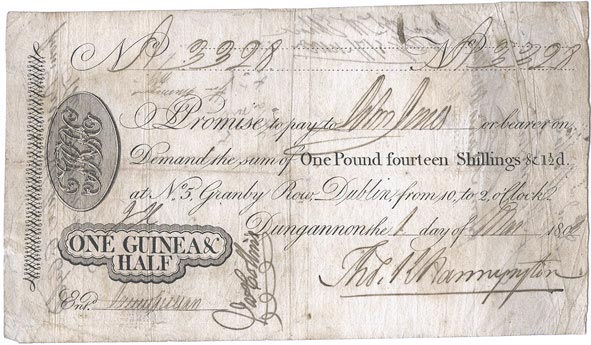
Thomas Knox Hannyngton. Dungannon, One Guinea and a Half, 1 March 1808 (One Pound, Fourteen Shillings and Three-Halfpence)
[7. noonans.co.uk, 2 Oct 2008, Lot 34]
Series 2. Dungannon Issue, payable in Dublin

Thomas Hannyngton's Bank. Dungannon and Dublin, Thirty Shillings, 1 May 1806
[8. noonans.co.uk, 29 Sept 2005, Lot 2014]

Hannyngton's Bank. Dungannon, One Guinea, 1st Oct 1807
[9. noonans.co.uk, 29 Sept 2011, Lot 4293]
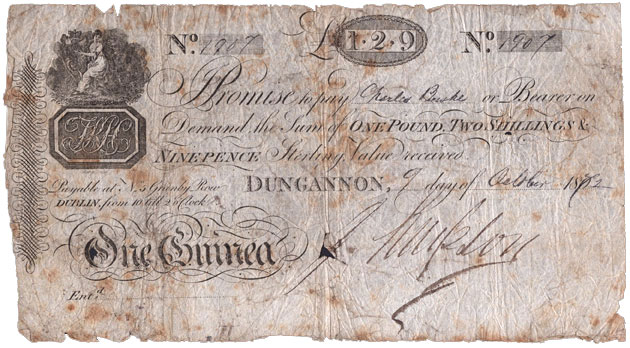
Hannyngton's Bank. Dungannon, One Guinea, 9th Oct 1812
[11. noonans.co.uk, 28 March 2019, Lot 290]

Hannyngton's Bank. Dungannon, One Guinea, 1st May 1815
Series 3. Dublin Issue, payable in Dublin
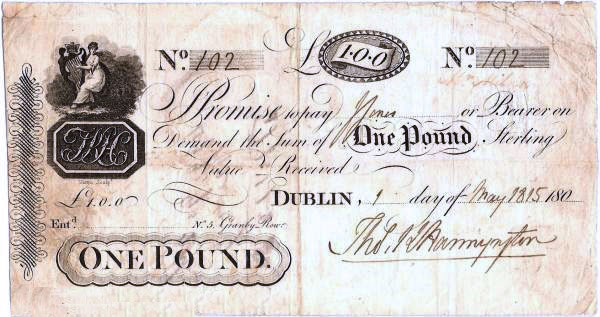
Hannyngton's Bank. Dublin, One Pound, 1 May 1815
Series 4. Dublin Issue post bills, payable in Dublin

Hannyngton's Bank. Dublin, Three Pounds Bank post bill, July 1815
[10. noonans.co.uk, 14 March 2009, Lot 489]
References
1. Barrow, G. L. (1975). The Emergence of the Irish Banking System 1820-1845, Gill & Macmillan.
2. Young, D. (July-August 1976). The Private Banks and Their Notes, Thomas Hannyngton of Dungannon and Dublin 1804-1816, Irish Numismatics Magazine, No. 52, pp. 139-140.
3. Dungannon Castle and the Knox-Hannyngtons.
4. Thomas Knox Hannyngton's age has been put at 63 on Geni (which lists a likely incorrect death date for him), and at 85 by caulfield [5]. We consider 85 to be more likely, with 63 being an erroneous derivation of his age being written as his date of birth, i.e. 1785 from age 85.
5. http://www.caulfeild.co.uk/family.php?famid=F198&ged=Caulfeild
6. https://www.cotyroneireland.com/burial/dungannon.html
7. Auction Catalogue, Noonan's (DNW), London. Important British, Scottish and World Paper Money, 2 Oct 2008.
8. Auction Catalogue, Noonan's (DNW), London. Important British and World Banknotes, 29 Sept 2005.
9. Auction Catalogue, Noonan's (DNW), London. British and World Paper Money, 29 Sept 2011.
10. Auction Catalogue, Noonan's (DNW), London. Important Collection of Irish Paper Money formed by Bob Blake (Part II), 14 March 2009.
11. Auction Catalogue, Noonan's (DNW), London. British and Irish Banknotes, 28 March 2019.